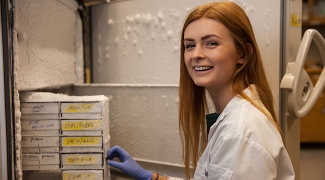Lay Science Writing Competition 2024: Evaluating umbilical cord blood transfusion efficacy and safety in neonates
Thursday, October 17, 2024 Mahsa Yazdanbakhsh
Our partnership with the Centre for Blood Research (CBR) at the University of British Columbia is helping to train the next generation of researchers in transfusion science. This blog post highlights just some of the achievements in education, training or knowledge mobilization accomplished by CBR trainees.
Canadian Blood Services 2024 Lay Science Writing Competition offered in partnership with the Centre for Blood Research (CBR) provides research trainees an opportunity to exercise and enhance their science communication skills by sharing their research with lay audiences. The competition was open to research trainees in the broad Canadian Blood Services research network – including trainees that are directly funded by Canadian Blood Services, in laboratories that receive funding from Canadian Blood Services, and at the Centre for Blood Research in Vancouver. In this blog, graduate student Mahsa Yazdanbakhsh, author of the third prize-winning entry, provides some behind-the-scenes insights into the preparation of her submission. The full entry text is also shared below.

Why did you choose to participate in the competition this year?
I chose to participate in the competition because it gave me a chance to highlight important research in neonatal blood transfusion, specifically focusing on umbilical cord blood (UCB) transfusions for extremely premature newborns. I saw this as an opportunity to show how UCB could improve survival and outcomes for these vulnerable babies. Since I’m involved in this research, I felt it was important to share my insights and the potential benefits this work could bring to neonatal medicine.
The theme this year was “Connecting science with society”; what did this theme mean to you?
The theme was particularly meaningful to me because it emphasizes the importance of making scientific discoveries accessible and relevant to the broader public. For me, it’s about bridging the gap between complex research and real-world applications that can improve lives. In our work on umbilical cord blood transfusions for premature infants, the potential benefits go beyond the laboratory—they directly impact vulnerable newborns. This theme reminded me that research is not just about advancing knowledge within the scientific community, but also about ensuring that society understands and benefits from these advancements. By participating in this competition, I aimed to contribute to this connection, demonstrating how science can address critical healthcare challenges and ultimately improve outcomes for neonates.
Did the writing process help you learn or discover something new about your research?
Yes, the writing process helped me gain a new perspective on our research. It required me to step back and think about how to explain complex scientific concepts in a way that is clear and relatable to a wider audience. This helped me see my work from a different angle, focusing not just on the technical aspects, but also on the broader impact it could have on neonatal care. Writing about my research also reinforced the importance of effective science communication, reminding me that research isn't just about what happens in the lab, but how it can be applied to make a real difference in society.
What tips would you share with others who are writing about research for lay audiences?
When writing about research for lay audiences, I recommend simplifying complex ideas without losing the essence of the work. Break down the concepts into clear and simple language, but ensure key details remain intact. I suggest focusing on why the research matters by connecting it to real-world applications or benefits, helping readers understand its relevance. Avoid jargon whenever possible, and if you need to use technical terms, explain them in an accessible way. I also recommend using relatable examples to make complex concepts easier to grasp. Present the research in an engaging way, perhaps by telling a story or highlighting its human impact.
Read the prize-winning entry in its entirety below...
Evaluating umbilical cord blood transfusion efficacy and safety in neonates
Imagine a small infant who was born prematurely and is having a hard time surviving in the outside world. These extraordinarily early newborns, referred to as ELGANs (Extremely Low Gestational Age Newborns), are born before 28 weeks of pregnancy and must fight a losing battle against anemia, a disorder in which there are insufficient healthy red blood cells in their blood to carry oxygen throughout their bodies. A common strategy used by physicians to win this conflict is blood transfusions. These transfusions now depend on adult donors' blood. This method, while life-saving, has limitations. Adult blood cells might not always meet these delicate babies' unique needs, which could occasionally result in complications and less positive results. But what if there was a more efficient method?
Umbilical cord blood (UCB) has been proposed as a treatment for anemia in infants in the past. Fetal hemoglobin (HbF), a particular type of hemoglobin that is beneficial at carrying oxygen and protecting cells from harm, is rich in UCB. The fragility of fetal red blood cells and low volumes presented practical challenges that led to a decline in the use of UCB, despite its promising results. However, scientists are now looking again at this overlooked hero. They think that the secret to safer and more efficient treatments for premature babies may lie with UCB. According to recent research, UCB may be able to supply the necessary transfusions, and ongoing clinical trials are examining its advantages over adult blood.
How to store UCB is a big obstacle when using it. UCB has a shorter life span than adult blood, which can be kept in storage for longer periods of time. Scientists are actively working on new methods to freeze and store UCB so it can be readily available when needed. This process is known as cryopreservation. Our research team has developed a meticulous method to freeze and thaw UCB. This technique, involving the addition and removal of a substance called glycerol, aids in protecting the blood cells during the freezing process. Having demonstrated the effectiveness of this method with adult blood, we are now adapting it for UCB.
Our research is guided by three primary objectives: optimizing the freezing process, minimizing immune reactions, and assessing survival rates. By refining our freezing and thawing methods, our aim is to ensure that UCB cells remain healthy and functional. Furthermore, we seek to compare how the immune system responds to UCB and adult blood to ascertain the safety and efficacy of UCB transfusions. Lastly, we will evaluate the survival of UCB cells after cryopreservation and thawing, comparing them to adult blood cells. Success in these endeavors could offer a more potent treatment for anemia in premature babies, leading to improved health outcomes and fewer complications, thereby revolutionizing neonatal care and providing these vulnerable recipients with a stronger start in life.
In conclusion, our research in Dr. Jason Acker's lab on UCB aims to address the critical needs of premature infants by optimizing cryopreservation techniques, understanding immune responses, and comparing the efficacy of UCB to adult blood. The potential benefits of utilizing UCB are immense, and if successful, this work could transform the landscape of neonatal transfusions, offering these vulnerable babies a better chance at a healthy start in life.
About the author:
Mahsa's research is supported by the Canadian Blood Services Graduate Fellowship Program award. In her work, Mahsa focuses on optimizing blood manufacturing methods and investigating how to improve the efficacy of blood transfusion.
Canadian Blood Services – Driving world-class innovation
Through discovery, development and applied research, Canadian Blood Services drives world-class innovation in blood transfusion, cellular therapy and transplantation—bringing clarity and insight to an increasingly complex healthcare future. Our dedicated research team and extended network of partners engage in exploratory and applied research to create new knowledge, inform and enhance best practices, contribute to the development of new services and technologies, and build capacity through training and collaboration. Find out more about our research impact.
The opinions reflected in this post are those of the author and do not necessarily reflect the opinions of Canadian Blood Services nor do they reflect the views of Health Canada or any other funding agency.
Related blog posts
The 2024 Canadian Blood Services’ Lay Science Writing Competition is open for submissions from research trainees in Canadian Blood Services’ research network until Friday, June 14, 2024. The theme this year is: “Connecting science with society”. Additional competition details available in this post!
Canadian Blood Services research trainees reflect on the 2024 Canadian Society for Transfusion Medicine (CSTM) conference and their experience as planning committee members for Canadian Blood Services’ Research Day.
Announcing the winning entries from the Canadian Blood Services Research 180 Video Competition showcasing “Impact in motion”!


